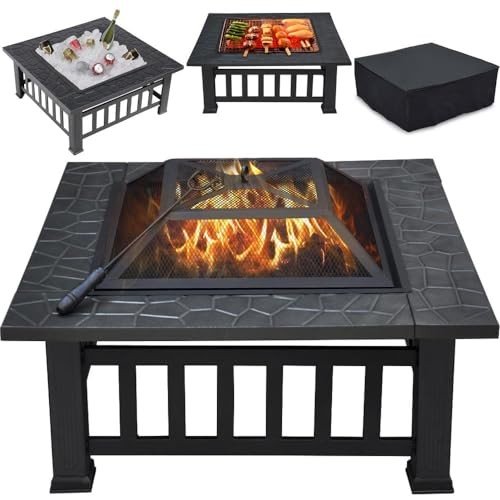The Fireplace: A Warm Embrace of Tradition and Comfort
Fireplaces have actually been an important part of human habitation for centuries, serving as a source of heat, a meeting place, and a sign of convenience. While the modern variations may differ remarkably from their ancient ancestors, the attraction of a fireplace sustains. This post checks out the various elements of fireplaces, including their history, function, types, and maintenance, while likewise attending to frequently asked concerns.
The Evolution of Fireplaces
Fireplaces date back to ancient times when open flames were used for cooking, heating, and defense from wildlife. Over the centuries, fireplaces developed from easy fire pits to the advanced renditions we see today. Here is a short timeline of their advancement:
- Prehistoric Era: Cavemen utilized open flames for warmth and cooking. Wind and smoke typically blew into homes.
- Middle Ages: Stone and brick fireplaces ended up being typical in homes and castles, including chimneys to bring smoke outside.
- Renaissance: Elaborately created mantels emerged, and fireplaces ended up being centers of social interaction.
- Industrial Revolution: Innovations in heating products caused a range of styles and functionalities.
- Modern Era: The advent of gas, electric, and bioethanol fireplaces provided cleaner options to traditional wood-burning units.
Table 1: The Evolution of Fireplaces
| Age | Qualities |
|---|---|
| Prehistoric Era | Open flames for heat and cooking |
| Middle Ages | Stone and brick structures with early chimneys |
| Renaissance | Ornate mantels, social centers |
| Industrial Revolution | Diverse styles, arrival of brand-new products |
| Modern Era | Gas, electric, and bioethanol options |
The Purpose of a Fireplace
Fireplaces serve double functions: they provide physical warmth and develop an emotional environment. Fireplaces Online collect around the fireplace to bond, share stories, and delight in a cozy setting. The glow of a fire can be relaxing, contributing to a sense of relaxation and intimacy. Beyond personal enjoyment, fireplaces likewise offer functional benefits, including:
- Home Heating: Effective heat source, specifically in chillier climates.
- Increased Home Value: A well-designed fireplace can enhance the aesthetic value of a home.
- Emergency situation Heating: In case of power blackouts, wood-burning fireplaces can work as an important heat source.
- Aesthetic Appeal: A centerpiece that contributes to interior decor.
Types of Fireplaces
Today, fireplaces can be found in various styles and fuel types, accommodating a varied range of choices and settings. Here are some common types:
Wood-Burning Fireplaces:
- Traditional fire pits
- Traditional masonry fireplaces
- Require substantial upkeep and chimney upkeep
Gas Fireplaces:
- Available in both direct vent and ventless ranges
- Much easier to use and keep than wood-burning fireplaces
- Provide instantaneous heat with a flick of a switch
Electric Fireplaces:
- Offer associated heat sources without genuine flames
- Typically developed to simulate traditional fireplaces
- Ideal for smaller sized areas and homes without a chimney
Bioethanol Fireplaces:
- Use bioethanol fuel, supplying a sustainable alternative
- Require no ventilation and can be positioned anywhere
- Safe and simple to keep
Table 2: Types of Fireplaces
| Type | Fuel Source | Features | Upkeep Requirements |
|---|---|---|---|
| Wood-Burning | Wood | High ambiance, heat source | Regular chimney cleansing |
| Gas | Natural gas or lp | Instantaneous heat | Minimal, periodic maintenance |
| Electric | Electrical power | Easy setup | Really low maintenance |
| Bioethanol | Bioethanol fuel | Ventless, portable | Low, mainly cleaning up |
Maintenance and Safety Considerations
Owning a fireplace includes specific responsibilities, particularly regarding its safe operation and long-term upkeep. Here are essential upkeep suggestions and security guidelines:
Maintenance Tips:
- Annual Inspection: Always have your chimney and fireplace inspected a minimum of once a year by a qualified specialist.
- Routine Cleaning: Clean out ashes and debris after each usage, and ensure the flue is open before beginning a fire.
- Examine for Cracks: Inspect masonry for cracks or damage to avoid structural issues.
- Use Proper Fuel: Only use dry, skilled wood for wood-burning fireplaces; do not burn cured wood.
Security Guidelines:
- Install Smoke Detectors: Ensure smoke detectors are practical, testing them regular monthly and replacing batteries as needed.
- Keep a Fire Extinguisher: Have one neighboring, even if a fireplace is utilized rarely.
- Monitor Flames: Never leave a fire ignored, and ensure children and animals are kept track of around the fireplace.
Often Asked Questions (FAQs)
1. How can Fireplace Deals UK decrease smoke from a wood-burning fireplace?
To reduce smoke, use dry, skilled wood, and ensure that your chimney is tidy and unobstructed.
2. Is it safe to utilize gas fireplaces throughout a gas leakage?
Never use a gas fireplace throughout a gas leak. Immediately evacuate the location and contact gas services for assistance.
3. Can I install an electric fireplace myself?
Electric fireplaces are generally easy to set up, but it is advised to speak with professionals to make sure safety and compliance with regional building regulations.
4. What is the best kind of fireplace for small areas?
Electric fireplaces or bioethanol models are frequently best for small spaces, as they do not require substantial ventilation or structural adjustments.
Fireplaces have actually transcended their original function of offering heat to become cherished components of home design and household life. They evoke memories of warmth, events, and togetherness while supplying functional advantages that enhance modern living. By understanding the different kinds of fireplaces, their upkeep, and safety practices, homeowners can take pleasure in the ageless appeal of this cherished function for generations to come.

